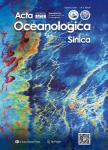Dynamical analysis of mesoscale eddy-induced ocean internal waves using linear theories
Dynamical analysis of mesoscale eddy-induced ocean internal waves using linear theories作者机构:Institute of Space and Earth Information Science The Chinese University of Hong Kong Hong Kong China Department of Atmospheric and Oceanic Science University of Maryland College Park Maryland USA Physical Oceanography Laboratory Ocean University of China Qingdao 266100 China Jet Propulsion Laboratory California Institute of Technology Pasadena California USA Key Laboratory for Marine Science and Numerical Modeling of State Oceanic Administration First Institute of Oceanography State Oceanic Administration Qingdao 266061 China
出 版 物:《Acta Oceanologica Sinica》 (海洋学报(英文版))
年 卷 期:2008年第27卷第3期
页 面:60-69页
核心收录:
学科分类:0710[理学-生物学] 0908[农学-水产] 07[理学] 0707[理学-海洋科学]
基 金:The RGC under contract No.461907 the ONR under contract Nos N00014-05-1-0328and N00014-05-1-0606 the SFMSBRP under contract No.973-2007CB411807 the NASA JPL under contract No.NMO710968
主 题:ocean internal waves mesoscale eddy current field instability SAR image
摘 要:This study aims to explore generation mechanisms of the ocean internal wave using the dynamical analysis methods based on linear theories. Historical cruise measurements and recent synthetic aperture radar (SAR) observations of mesoscale eddies with diameter of several tens of kilometers to hundreds of kilometers show that the internal wave packets with wavelength of hundreds of meters to kilometer exist inside the mesoscale eddies. This coexistence phenomenon and inherent links between the two different scale processes are revealed in the solutions of governing equations and boundary conditions for the internal wave disturbance with a horizontally slowly variable amplitude in a cylindrical coordinate system. The theoretical solutions indicate that the instability of eddy current field provides the dynamical mechanism to internal wave generation. The derived dispersion relation indicates that the internal wave propagation is modified by the eddy current field structure. The energy equation of the internal waves clearly shows the internal wave energy increment comes from the eddy. The theoretical models are used to explain the observation of the mesoscale eddy-induced internal waves off the Norwegian coast. The two-dimensional waveform solution of the anticyclonic eddy-induced internal wave packet appears as ring-shaped curves, which contains the typical features of eddy stream lines. The comparison of theoretical solutions to the structure of the internal wave packets on SAR image shows a good agreement on the major features.



